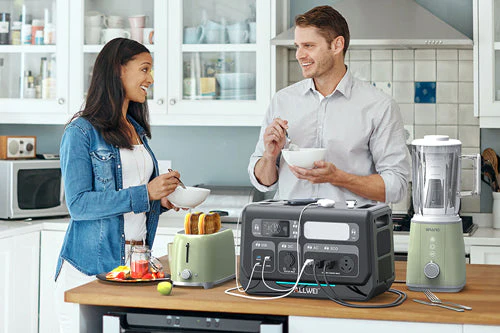The modern world runs on electricity, yet the stability of our power grid is often taken for granted until it fails. A sudden power outage, whether caused by severe weather, equipment failure, or high demand, can plunge a household into darkness and disruption. Communication lines can go down, essential medical devices may cease to function, and even basic comforts become unavailable. This dependence on a potentially fragile grid highlights the critical need for effective home backup solutions. While traditional options like gasoline generators exist, they come with significant drawbacks. Enter the Allwei portable power station, a modern, versatile, and increasingly popular alternative that provides clean, quiet, and reliable performance when you need it most. This article details how an Allwei unit can serve as an essential component of your home backup strategy, offering peace of mind and crucial power during unexpected outages.
For decades, the go-to solution for significant home backup power has been the gasoline-powered generator. While capable of high power output, these machines suffer from considerable disadvantages, especially for residential use. They are notoriously noisy, produce harmful exhaust fumes requiring outdoor operation (often in inclement weather), necessitate safe storage and handling of flammable fuel, and demand regular maintenance to ensure they start when needed. Another option, the Uninterruptible Power Supply (UPS), is commonly used for computers and sensitive electronics. However, typical UPS units offer very limited battery capacity and low AC output, designed primarily to allow safe shutdown during brief interruptions, not to run larger appliances or provide extended backup. The Allwei portable power station neatly overcomes the limitations of both. It operates silently, produces zero fumes making it safe for indoor use, requires no fuel storage or engine maintenance, and offers substantial battery capacity capable of powering essential devices for hours, or even days, depending on the model and load. Its inherent portability also means it can be easily moved to where power is needed within the home, offering flexibility that fixed backup systems lack.
Several key features make Allwei portable 1200 watt power station particularly well-suited for emergency home backup. Central to their function is the combination of battery capacity and AC output. Models vary, offering different Watt-hour (Wh) ratings (the amount of energy stored) and maximum output Watt (W) ratings (the rate at which power can be delivered). Choosing a unit with sufficient capacity and output is crucial for running your specific essential devices. Equally important is the quality of the power delivered. Allwei units typically employ a pure sine wave inverter. This technology is vital because it produces clean, stable AC output that closely mimics the electricity from the grid, ensuring the safe and efficient operation of sensitive modern appliances and small electronics, including computers, TVS, and critical medical equipment like CPAP machines. Unstable power from modified sine wave inverters (found in cheaper alternatives) can potentially damage such devices. Furthermore, Allwei stations provide multiple AC outlets, allowing you to power several items simultaneously, alongside USB and DC ports for charging phones and other gadgets. The inclusion of fast charging capabilities is another significant benefit, enabling the power station to be quickly recharged from a wall outlet once grid power is restored, ensuring it’s ready for a potential subsequent power outage with a full charge. Perhaps most critically for extended outages, many Allwei models feature solar charging capability. By connecting compatible solar panels, you can transform the unit into a mini solar generator, replenishing its battery capacity using sunlight even when the grid remains down. This solar readiness offers a path to sustained power, potentially drawing conceptual parallels to using energy generated from a balcony power plant or balkonkraftwerk setup to charge the portable unit, further enhancing energy resilience.
During a power outage, an Allwei portable power station can keep your essential systems running. Prioritize critical needs: communication devices (charging phones, powering routers/modems if the internet service itself is still active), essential medical equipment (CPAP machines, monitors), and basic lighting (energy-efficient LEDs are recommended). Depending on the Allwei model’s battery capacity and maximum output, you might also power a small refrigerator or freezer intermittently to preserve food, run a fan for ventilation, keep small electronics charged for information or entertainment, or even power a microwave for brief periods to heat food. Understanding the watt consumption of each appliance is key to managing the load and maximizing runtime. The reliable performance of the Allwei, governed by its internal Battery Management System (BMS), ensures stable voltage and protects both the battery and connected devices from issues like overload or short circuits.
Integrating an Allwei into your home preparedness plan involves strategic thinking. First, identify the truly essential devices you need to power during an outage and determine their combined wattage. This will guide your selection of an Allwei model with adequate maximum output and battery capacity. Consider where you will store the unit – it should be easily accessible, kept in a cool, dry place, and ideally maintained at a partial charge (e.g., 80%) for battery health, ready to be brought to a full charge if an outage seems imminent. Keep the necessary charging cables (AC wall outlet charger, potentially solar panel connectors) with the unit. Regularly test the power station (e.g., every few months) by charging it fully and plugging in a few devices to ensure it’s functioning correctly. Familiarize yourself with its operation and display indicators.
When selecting your Allwei home backup system, carefully assess your household’s specific needs. A small apartment needing only to power lights, phones, and a CPAP machine will require a different capacity model than a larger home hoping to keep a refrigerator running. Compare different Allwei models based on their Wh capacity, continuous and peak AC output (watt), the number and type of AC outlets and other ports, recharge times (especially fast charging specs), and solar charging input capabilities. Don’t overlook the manufacturer’s warranty, which provides assurance regarding the unit’s long-term reliable performance and protects your investment.
In conclusion, securing your home against the disruption of power outages is a prudent measure in today’s world. The Allwei portable power station offers a compelling, modern solution for home backup, surpassing traditional generators and basic uninterruptible power supply units in terms of safety, silence, ease of use, and indoor operational flexibility. With features like substantial battery capacity, clean pure sine wave AC output, multiple AC outlets, fast charging, and crucially, solar panel compatibility turning it into a potential solar generator, Allwei provides reliable performance to keep your essential appliances and small electronics running when the grid goes dark. By carefully choosing the right model for your needs and integrating it thoughtfully into your emergency plan, you can significantly enhance your home’s resilience and ensure greater safety and comfort during unforeseen power outages, powered by Allwei.






